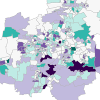Spatial pattern of environmental perception and place attachment in a diverse socio-economic context: the case of Gauteng province, South Africa
DOI:
https://doi.org/10.5311/JOSIS.2022.25.174Keywords:
Environmental perceptions, place attachment, cluster analysis, geographically weighted regression, socio-economic factorsAbstract
There is limited consensus among researchers on whether the spatial distribution of environmental perceptions and place attachment is influenced by socio-economic factors. This study aimed to determine if environmental perceptions and place attachment concepts in our study area (within Gauteng province, South Africa) showed specific spatial patterns. Hot spot, cluster-outlier analysis, and geographically weighted regression (GWR) were used to depict the spatial patterns of environmental perceptions and place attachment. Results showed a pattern where the central, generally affluent wards of the province hold more positive environmental perceptions and place attachment than those in the periphery. This is in line with dependency and other models that associate lower socio-economic status with lower levels of environmental awareness but is incongruent with other findings that have associated lower socio-economic status with pro-environmental behaviour being more prominent. Geographically weighted regression results revealed the combined importance of numbers of people with above-average income, college-level education, age below 50 years, female proportion, formal dwelling residence and African race in explaining the numbers of people with positive views on place attachment and environmental perceptions. Further, the GWR modelling allowed for the spatial dependence of the relationship between place attachment and environmental perceptions on the one hand and socio-economic factors on the other. These results have significant implications for environmental sustainability, planning and policy formulation in the province.

Downloads
Published
Issue
Section
License
Copyright (c) 2022 Simangele Dlamini, Solomon G. Tesfamichael, Gina Weir-Smith, Tholang Mokhele

This work is licensed under a Creative Commons Attribution 3.0 Unported License.
Articles in JOSIS are licensed under a Creative Commons Attribution 3.0 License.
